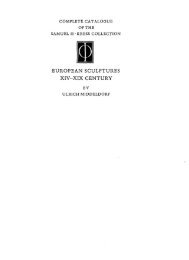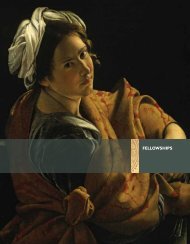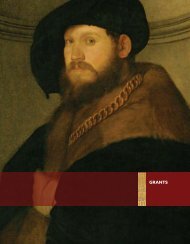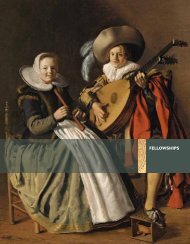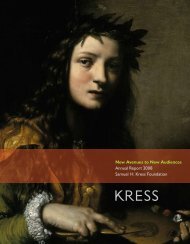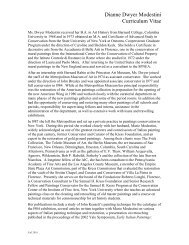The Campus Art Museum - Samuel H. Kress Foundation
The Campus Art Museum - Samuel H. Kress Foundation
The Campus Art Museum - Samuel H. Kress Foundation
You also want an ePaper? Increase the reach of your titles
YUMPU automatically turns print PDFs into web optimized ePapers that Google loves.
Appendix B<br />
Example Responses of Why Respondents Become Interested<br />
in <strong>Art</strong> and <strong>Art</strong> <strong>Museum</strong>s<br />
Influencing<br />
Factors<br />
<strong>Art</strong><br />
Course<br />
Example Response<br />
“When I was a young kid… I was always high energy and the first person done on tasks, the<br />
first person done on everything and had a lot of time to fill. And I was always sketching and<br />
always drawing. In my school system… they didn’t have an art program. So in second grade, my<br />
classroom teacher, one of my favorite people I remember for many reasons and this is one of<br />
them… she had this parent-teacher conference and told my mother, ‘you have to get this kid art<br />
lessons….’ So I started private painting lessons as a seven year old and my mother made sure I<br />
could go once a week and do drawing and painting with our, at that time, most important painter<br />
in Paris, Illinois. And so, I very early had art lessons.” (curator of education)<br />
“I loved cartoons when I was little…. My father and mother were farmers, but I was always drawn<br />
to imagery and sequential artwork. I don’t know, I always liked to keep my hand busy…. I had the<br />
opportunity to take art classes at a regional art center and that really got me introduced to print<br />
making.” (graduate student)<br />
“When I was in high school, the emphasis was on sciences and if you were good at school you<br />
were supposed to become a doctor or a dentist or that sort of thing so I enrolled in pre-med…<br />
but before doing that, I decided I’d get my fill of the arts by doing a one year foundation program<br />
at a really really small school… that taught the history of science, history of math, history of music,<br />
history of literature, history of art and that was my very first art history class. So I had that oneyear<br />
program under my belt and then I went to [the university] and discovered that the sciences<br />
just didn’t do it for me anymore. I wanted to get back to the liberal arts and by that time it was<br />
too late to transfer so I spent a year and a half in France teaching English to a family there and also<br />
taking French classes. And then, at that point, I went to Baylor and Baylor had an interdisciplinary<br />
program that allowed you pretty much to choose your own major and so I did everything from<br />
philosophy to German and French literature to Latin and music. You could pretty much take<br />
whatever you wanted. Toward the end of my degree, the last two years, you were supposed<br />
to declare a concentration of some sort and I took some more art history because I had been<br />
interested every since I had that first class… and had, of course, been to tons of museums when I<br />
was in Europe, so I started taking more art history classes at Baylor and just realized that that was<br />
what I wanted to pursue in graduate school.” (graduate student)<br />
“My connection to art is one of those fluky things in college. I stumbled onto somebody who was<br />
reading a huge book and I asked her what it was. It was Jansen. She said it was art history 101, she<br />
was loving it. I was a freshman and so I took it the next semester. And I just loved art history. I had<br />
never liked history, but art history suddenly made all of history come alive… so I stayed with it….<br />
I loved it… art history felt like what I wanted to know.” (art education professor)<br />
Appendix B<br />
22



